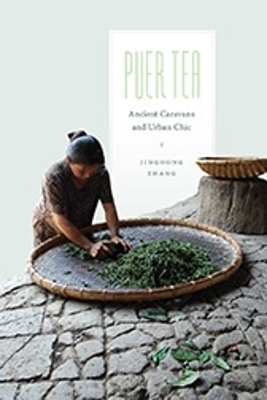
Puer Tea
Ancient Caravans and Urban Chic
Seiten
2013
University of Washington Press (Verlag)
978-0-295-99322-5 (ISBN)
University of Washington Press (Verlag)
978-0-295-99322-5 (ISBN)
Puer tea has been grown for centuries in the "Six Great Tea Mountains" of Yunnan Province. In imperial China it was a prized commodity, traded to Tibet by horse or mule caravan via the so-called Tea Horse Road and presented as tribute to the emperor in Beijing.
Puer tea has been grown for centuries in the “Six Great Tea Mountains” of Yunnan Province, and in imperial China it was a prized commodity, traded to Tibet by horse or mule caravan via the so-called Tea Horse Road and presented as tribute to the emperor in Beijing. In the 1990s, as the tea’s noble lineage and unique process of aging and fermentation were rediscovered, it achieved cult status both in China and internationally. The tea became a favorite among urban connoisseurs who analyzed it in language comparable to that used in wine appreciation and paid skyrocketing prices. In 2007, however, local events and the international economic crisis caused the Puer market to collapse.
Puer Tea traces the rise, climax, and crash of this phenomenon. With ethnographic attention to the spaces in which Puer tea is harvested, processed, traded, and consumed, anthropologist Jinghong Zhang constructs a vivid account of the transformation of a cottage handicraft into a major industry—with predictable risks and unexpected consequences.
Watch the associated videos at https://archive.org/details/PUERTEADVD1.
Puer tea has been grown for centuries in the “Six Great Tea Mountains” of Yunnan Province, and in imperial China it was a prized commodity, traded to Tibet by horse or mule caravan via the so-called Tea Horse Road and presented as tribute to the emperor in Beijing. In the 1990s, as the tea’s noble lineage and unique process of aging and fermentation were rediscovered, it achieved cult status both in China and internationally. The tea became a favorite among urban connoisseurs who analyzed it in language comparable to that used in wine appreciation and paid skyrocketing prices. In 2007, however, local events and the international economic crisis caused the Puer market to collapse.
Puer Tea traces the rise, climax, and crash of this phenomenon. With ethnographic attention to the spaces in which Puer tea is harvested, processed, traded, and consumed, anthropologist Jinghong Zhang constructs a vivid account of the transformation of a cottage handicraft into a major industry—with predictable risks and unexpected consequences.
Watch the associated videos at https://archive.org/details/PUERTEADVD1.
Jinghong Zhang is a lecturer at Yunnan University.
Foreword
Acknowledgments
Transliteration, Names, and Measures
Maps
Introduction
Spring
1. “The Authentic Tea Mountain Yiwu”
2. Tensions under the Bloom
Summer
3. “Yunnan: The Home of Puer Tea” 81
4. Heating Up and Cooling Down 106
Autumn
5. Puer Tea with Remorse
6. Transformed Qualities
Winter
7. Tea Tasting and Counter–Tea Tasting
8. Interactive Authenticities
Conclusion: An Alternative Authenticity
Appendix 1: Puer Tea Categories and Production Process
Appendix 2: Supplementary Videos
Notes
Glossary
References
Index
| Erscheint lt. Verlag | 1.12.2013 |
|---|---|
| Reihe/Serie | Culture, Place, and Nature |
| Mitarbeit |
Herausgeber (Serie): K. Sivaramakrishnan |
| Zusatzinfo | 47 illus. |
| Verlagsort | Seattle |
| Sprache | englisch |
| Maße | 152 x 229 mm |
| Gewicht | 499 g |
| Themenwelt | Sachbuch/Ratgeber ► Essen / Trinken ► Getränke |
| Geisteswissenschaften ► Geschichte ► Regional- / Ländergeschichte | |
| Sozialwissenschaften ► Ethnologie | |
| Sozialwissenschaften ► Soziologie ► Spezielle Soziologien | |
| ISBN-10 | 0-295-99322-7 / 0295993227 |
| ISBN-13 | 978-0-295-99322-5 / 9780295993225 |
| Zustand | Neuware |
| Informationen gemäß Produktsicherheitsverordnung (GPSR) | |
| Haben Sie eine Frage zum Produkt? |
Mehr entdecken
aus dem Bereich
aus dem Bereich
das Praxis-Handbuch für Kaffeeliebhaber, Baristas und Espresso-Fans
Buch | Hardcover (2023)
Edel Verlagsgruppe
CHF 38,90


